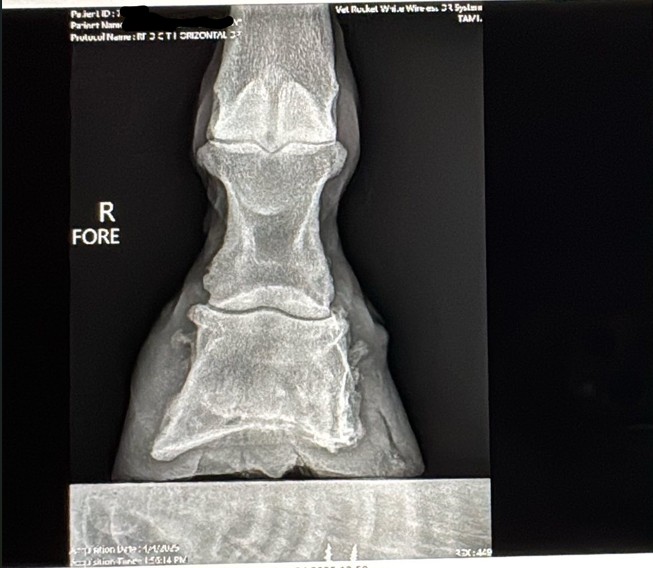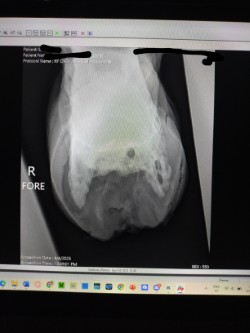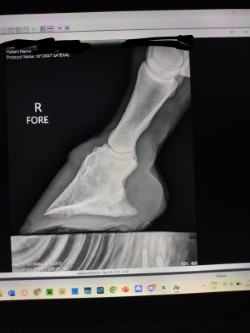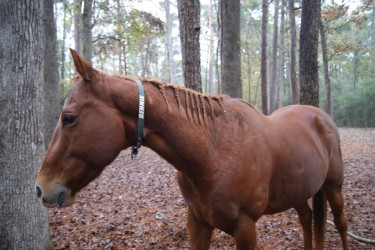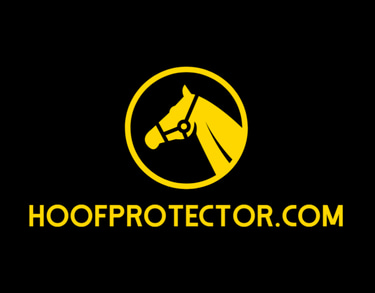Rennies story
The story of Rennie, a wonder to the medical world and the spark for my business
Rennies story
Rennie, a 2016 AQH, is a medical mystery; by all means, he shouldn't be standing, running, or jumping around the paddock. He was rescued in 2023 by a small family who help horses, skin and bones with a severe and constant limp in his right foreleg. We got him in February 2024, a great weight, but he still had a mysterious lameness that we couldn't figure out. After research, I found scoot boots. They took him from constant 3-4/5 lameness to a 1-2 lameness. Sound to be ridden (although he is just a paddock pet) We took x-ray at Texas A&M, the whole team was shocked, wondering how he is still alive with full fusion of his coffin, navicular and P3. His not only walking, but he is sound, happy, and a loving liberty pony. He came from a background of severe abuse. He has the physical and emotional scars of control-based training methods that left deep trauma: rope burns, whip marks, slashed legs, and twisted ears told a story of cruelty I wouldn’t wish on any animal. He had spent his final months before rescue in the auction pipeline.
From Survival to Thriving
Rennie isn’t just moving he’s thriving. What once seemed impossible has become his reality. His journey isn’t just about overcoming physical hardship; it’s about reclaiming his spirit. Gone is the dull and scared look in his eyes. Instead, he watches the world with cautious curiosity watching from afar unless his people are with him. His past may have left scars, but it no longer defines him. He had a short trail riding career for about a year, he LOVED riding out on the trails, going for a canter or just walking around.
The Decision to Retire
Making the choice to fully retire Rennie from riding wasn’t easy, but it was necessary. Just because he could be ridden didn’t mean he should. His internal structure, despite his soundness, simply isn’t built for a long riding career. While his boots helped him regain mobility and support his fragile joint in his lower leg, the fusion in his hoof means prolonged impact could take its toll. Rather than pushing the limits, I chose to prioritize his well-being, ensuring he lives a life where comfort and happiness come first.
Instead, I’ve focused on what he loves most liberty work, trick training, and long hand walks where he gets to explore at his own pace without the weight of a rider. He prefers the freedom to move without restraint, to express himself in ways that make him feel safe and seen. His days are filled with gentle interaction, playful movements, and the quiet assurance that he’ll never have to endure pain or abuse again.
Professionals and traditional views
Many people refused to touch Rennie in the beginning, long before we fully understood the severity of his internal condition. He fought back against harsh hands, rearing and lunging not out of aggression, but out of sheer desperation to protect himself. And I don’t blame him. He had endured more than most, and he was done being mistreated. He had learned that force meant pain, that submission led to suffering, and that the only way to protect himself was to fight back when given no other option.
One farrier lacked empathy entirely, insisting that restraint was the only answer. When Rennie resisted, refusing to yield, he told me, “Send this horse back to slaughter. He’s a lost cause. He’s had too much abuse.” The words cut deep, but what haunted me more was his approach so forceful that, in that moment, he was no better than the abusers Rennie had already endured. While he had done good elsewhere, even saving a neglected Tennessee Walker mare and giving her to me, his mindset was outdated built on control rather than understanding.
I turned back to Rennie’s old farrier, the only one he and I trusted, but his flare-ups worsened, and without clear x-rays, we had little understanding of what was truly happening inside his hoof. I consulted my vet about quality of life, corrective shoeing, and every option we had left. When Texas A&M provided new x-rays, the truth was undeniable. His fusion was so severe that most professionals believed there was no choice but euthanasia. One corrective shoer refused to even see him, stating simply, "The horse should be put down."
But the team at Texas A&M saw what I saw—Rennie was defying the odds. Corrective shoeing wasn’t the answer. Traditional shoes would only add more stress, but Scoot Boots gave him freedom. They allowed his hoof to move as naturally as possible, relieving pressure without restricting movement. The specialists were amazed—not just at his ability to move, but at how much the boots had helped him. Without them, he wouldn’t be sound. Without them, I would have had to make the hardest decision.
Against all expectations, Rennie is still here.
More Than Just a Boot
To me, Scoot Boots represent more than just a great product they’re a life saver especially for horses like Rennie. They gave him a second chance at movement, healing, and happiness.
If you're working with a horse recovering from hoof injuries, chronic cracks, or just need extra support during the healing process, I can’t recommend them enough. And if you ever need help choosing the right pair, feel free to reach out. I’m always here to help — because every horse deserves the chance to move pain-free, just like Rennie.
They can be used 24/7 in any condition, for horses with hoof problems or not, through any terrain or only ridden work on roads, endurance riding, cross country or trails. Every disciple is suitable for the scoot boots!
